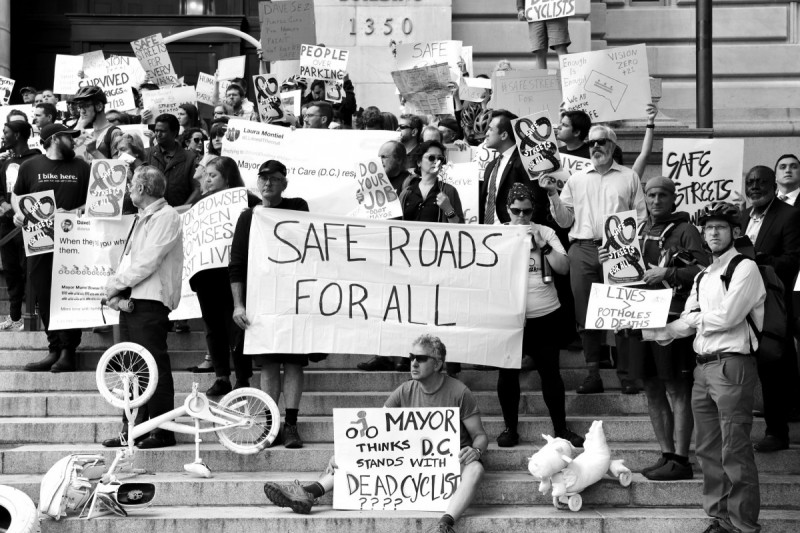Editor's note: A version of this article originally appeared on Greater Greater Washington and is republished with permission.
In American Sign Language, we call our translators interpreters for a reason: direct translation, or transliteration, is often not representative of the true meaning. For instance, the direct transliteration of Vision Zero is “zero vision.” Zero vision is not a good translation of Vision Zero, but it is a great representation of the current state of safe streets in DC and across the United States, especially for people with disabilities.
Vision Zero is a goal led by Swedish and Scandinavian countries, where the goal is to reduce traffic deaths to zero. This was a campaign promise of Mayor Bowser’s in 2014. Unfortunately, 40 people died on DC streets in 2021, the most since 2007.
Disabled people, seniors, and children are disproportionately affected when it comes to road safety. Disabled people use transit more, walk more and are less likely to drive, with both working and non-working disabled people less likely to own a car than those without disabilities.
For a number of reasons, many disabled people are disproportionately put at risk by unsafe sidewalks, overly large, fast and busy streets, and cities that are designed for cars, not people. As a result, disabled people are four times more likely to die in crashes.
What’s the solution?
All too often, we design streets and the city to cater around speeding up single-occupant vehicles, and neglect basic safety measures. Instead, DC’s road design should center high risk road users. A change in approach would not only make people with disabilities safer, but it would also drastically improve safety for other vulnerable road users including seniors and children.
The following are some best practices that would reallocate space from single-occupant vehicles and reprioritize pedestrians, with a focus on visual and physical access to spaces:
High risk users must lead design: Architects, designers, urban planners, and engineers should design spaces with people instead of for people. This isn’t just about a robust engagement process - it’s about letting these people lead. Hiring a disabled person to lead the process would help ensure that high risk road users are prioritized.
More time for pedestrians: Pedestrian intervals are often too short for disabled people, the elderly, and young children. Drivers hit pedestrians 60 percent less when leading intervals are implemented.
Calmer, safer streets: Road diets, which narrow streets, force drivers to slow down by design. Events that close off streets to traffic, like Open Streets DC and farmers markets, are another way to encourage better road use. And design features like raised crosswalks, bulb-outs, and curb extensions can make vulnerable pedestrians safer by making them more visible and reducing the time it takes to cross the street.
DeafScape: From deaf landscape architect Alexa Vaughn, this concept follows DeafSpace, where landscapes are designed for deaf people. While DeafSpace and DeafScape solutions were originally designed for deaf people, many other groups have benefited, including people with dementia, and people with autism.

Key features of DeafScape include:
- Wide sidewalks: Eight or more feet in width as a standard to ensure there is enough space for deaf people to converse (this also ensures enough space for wheelchair users)
- Shoulder zones: Tactile and visual cues that indicate the edge of a sidewalk or street.
- Eddies: Spaces for people to gather outside of the way of pedestrian traffic
- Wayfinding and sightlines: Thoughtful design that ensures clear navigation of busy streetscapes, including visibility of pedestrians, cars, and bike lane users at all times.
- Visual and tactile cues: This includes clearly painted streetlines, crosswalks, truncated domes and textural contrasts at curbs and busy streets to aid navigation for blind, low vision, and deaf-blind people.
The task is daunting, but disabled people have been at the forefront of meaningful transportation change like this before. One example is Fred Fay, a disabled person from Silver Spring who was part of the disability rights movement starting in the 1950s. Fay popularized “no taxation without transportation,” organizing 60 different groups to testify before Congress, resulting in the Urban Mass Transportation Access Act. Metro became a model in how mass transit systems could be both accessible and beautiful. While not perfect, Metro’s accessibility was groundbreaking for the time, because of the leadership of disabled people.
In Deaf culture, there is an understanding that we look out for each other when walking down the street, as sign language often requires visual attention and eye contact far more than speaking does. As we focus our visual attention on the person we are chatting with, we often warn each other about obstacles in our path and rely on tactile cues to help us navigate and chat at the same time.
Safe streets and addressing Vision Zero are the same: we need to look out for each other.
Sean Maiwald is a Deaf urbanist who is passionate about policy and politics.
Robb Dooling is Deaf, queer, and an Advisory Neighborhood Commissioner representing district 6A06, the eastern end of the H Street Corridor. He loves bike adventures to Harper's Ferry and beyond.






